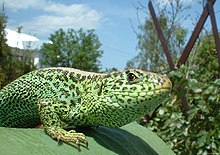Lacertidae
| Lacertids Temporal range: Oligocene–present, 24–0 Ma |
|
|---|---|
 |
|
| Sand lizard | |
| Scientific classification | |
| Kingdom: | Animalia |
| Phylum: | Chordata |
| Class: | Reptilia |
| Order: | Squamata |
| Superfamily: | Lacertoidea |
| Family: |
Lacertidae Oppel, 1811 |
| Type species | |
|
Lacerta agilis Linnaeus, 1758 |
|
| Subgroups | |
|
See text |
|
See text
The Lacertidae are the family of the wall lizards, true lizards, or sometimes simply lacertas, which are native to Europe, Africa, and Asia. The group includes the genus Lacerta, which contains some of the most commonly seen lizard species in Europe. It is a diverse family with hundreds of species in 39 genera.
The European and Mediterranean species live mainly in forest and scrub habitats.Eremias and Ophisops species replace these in the grassland and desert habitats of Asia. African species usually live in rocky, arid areas. Holaspis is one of the few arboreal lacertids, and its single species, Holaspis guentheri, is a glider (although apparently a poor one), using its broad tail and flattened body as an aerofoil.
Lacertids are small or medium-sized lizards. Most species are less than 9 cm long, excluding the tail, although the largest living species, Gallotia stehlini, reaches 46 cm, and some extinct forms were larger still. They are primarily insectivorous. An exception is Meroles anchietae, one of the few wall lizards that regularly eat seeds – an appropriate food for a lizard of the harsh Namib Desert.
Lacertids are remarkably similar in form, with slender bodies and long tails, but have highly varied patterns and colours, even within the same species. Their scales are large on the head, which often also has osteoderms, small and granular on the back, and rectangular on the underside. Most species are sexually dimorphic, with the males and females having different patterns.
At least eight species from the Caucasus are parthenogenetic, and three species give birth to live young, including the viviparous lizard, Zootoca vivipara.
...
Wikipedia
